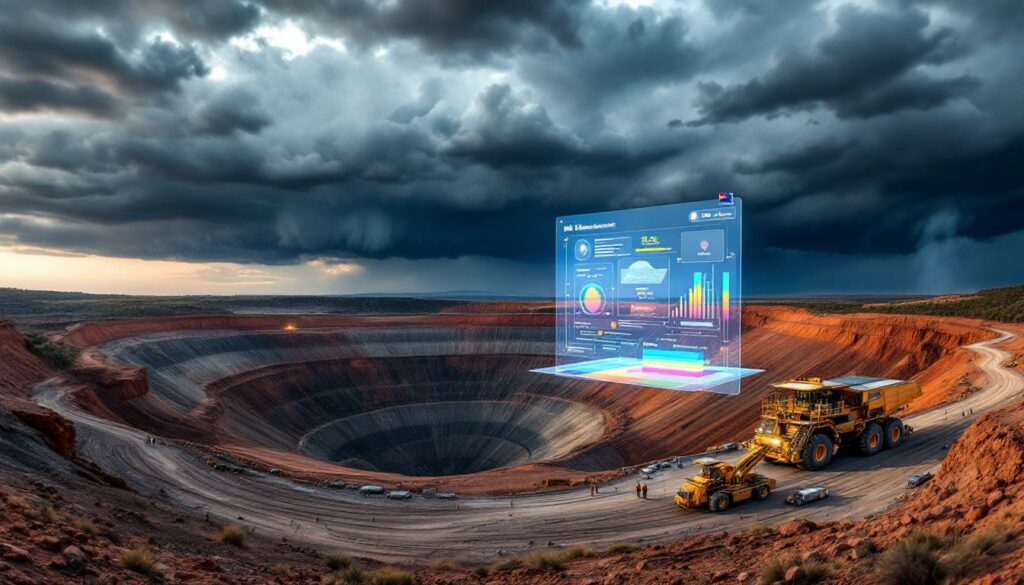Understanding Climate Risks in Australian Mining: Comprehensive Assessment and Mitigation Strategies
Australian mining operations face multiple climate-related threats that can significantly disrupt productivity, damage infrastructure, and impact long-term viability. Recent data shows over 70% of Australian executives have reported revenue or property losses due to unexpected climate events, yet surprisingly, 24% still rank climate risks and Australian mining operations as low or medium priorities according to FM and The Economist Impact's 2025 report.
Climate risks represent an existential challenge to the mining sector, with implications extending far beyond immediate operational disruptions to affect financial performance, investor confidence, and long-term strategic planning.
Key Climate Threats to Mining Infrastructure
The Australian mining sector faces four primary climate threats, each with unique characteristics and impact profiles:
Bushfires: Particularly prevalent in Western Australia, where 90% of the state is prone to bushfires despite hosting nearly 1,000 operating mines according to the WA Department of Fire and Emergency Services (2025). The increasing frequency and intensity of bushfires have transformed them from seasonal concerns to year-round threats requiring continuous vigilance.
Flooding: Has caused major infrastructure losses at multiple sites, including the complete destruction of key operational assets at 29Metals' Capricorn mine during the 2023 Queensland floods, as reported by ABC News. Recovery from major flood events typically costs over AU$100 million according to IBISWorld's Mining Risk Report (2024).
Cyclones: Often underestimated despite their potential to cause significant equipment damage and operational disruption. The Insurance Council of Australia's Catastrophe Report (2024) indicates insurable losses from cyclones have increased 150% since 2000, with the Pilbara region experiencing a 40% increase in cyclone frequency since 1990 according to Bureau of Meteorology data.
Indirect impacts: Including supply chain disruptions, workforce displacement, and power outages. The United Nations Environment Programme Finance Initiative (2024) highlights mining's particular vulnerability due to reliance on coastal infrastructure exposed to sea-level rise.
Beyond Direct Operational Sites
Mining operations frequently underestimate climate impacts on supporting infrastructure located far from the actual mine site:
-
Rail networks: The 2019-20 Black Summer bushfires caused Rio Tinto to report AU$25 million in losses from rail disruptions alone (Rio Tinto Annual Report 2020)
-
Shipping ports: Often located in coastal areas vulnerable to cyclones and sea-level rise
-
Power transmission lines: Susceptible to damage from multiple climate hazards
-
Supply chain logistics: The 2022 floods severed 80% of Queensland coal rail lines for three weeks according to Aurizon's operational reports
"Physical climate hazards pose material financial risks to mining assets through direct damage and operational disruptions" — UNEP Finance Initiative, 2024
How are bushfires specifically impacting Australian mining operations?
Bushfires represent one of the most severe climate threats to mining operations, particularly in hot, dry regions of Australia. The combination of longer heatwaves and drought conditions has intensified this risk significantly, with the CSIRO State of Climate 2024 reporting that "fire weather season has lengthened by 20-60 days since 1950 in mining regions."
Bushfire Vulnerability Assessment
-
Western Australia: 90% of the state is bushfire-prone while hosting nearly 1,000 operational mines (WA DFES, 2025)
-
Queensland: The 2024 bushfires demonstrated severe impacts on major mining operations, forcing multiple operational suspensions according to Mining Magazine
-
Infrastructure damage: Surface piping systems particularly vulnerable to fire damage, with conveyor systems and plastic components representing critical failure points
-
Operational disruptions: Extended site closures often necessary during and after fire events, with evacuation protocols triggering automatic production halts
Secondary Bushfire Impacts
-
Air quality degradation: Smoke can compromise mine ventilation systems, with particulate matter (PM2.5) levels exceeding 300μg/m³ during severe fire events according to NSW Department of Planning, Industry and Environment monitoring (2020)
-
Worker health risks: Respiratory hazards from particulate matter can reduce workforce availability by up to 30% during severe events
-
Access limitations: Transportation routes may be cut off, preventing staff rotation and supply deliveries
-
Recovery costs: Significant resources diverted to rebuilding efforts, with BHP investing AU$70 million in fire-resistant conveyor systems according to their 2023 Sustainability Report
"The increasing frequency and intensity of bushfires have transformed them from seasonal concerns to year-round threats requiring continuous monitoring and rapid response capabilities."
What flood-related risks do Australian mining operations face?
Flooding presents substantial challenges to mining operations, particularly those located near rivers or in coastal areas. Recent years have seen devastating flood impacts across multiple Australian mining regions, with recovery timelines often extending far beyond initial estimates.
Documented Flood Impacts
-
Queensland incident: Complete loss of key infrastructure at 29Metals' Capricorn mine during the 2023 floods, forcing a 12-month closure as reported by ABC News
-
Recovery timeline: Many flood-damaged operations require months or years to return to full capacity, with average recovery costs exceeding AU$100 million for major flood events according to IBISWorld's Mining Risk Report (2024)
-
Water management challenges: Overflow of tailings dams and contaminated water systems, with GRID-Arendal (2023) identifying that 23% of Australian tailings facilities are located in high-flood-risk zones
-
Production losses: Yancoal lost 1.2 million tonnes of coal production during the 2022 NSW floods according to their ASX announcement on March 15, 2022
Comprehensive Flood Risk Factors
-
Power infrastructure damage: Electrical systems particularly vulnerable to water intrusion, often requiring complete replacement after inundation
-
Supply chain disruptions: Transportation routes compromised, with the 2022 floods severing 80% of Queensland coal rail lines for three weeks
-
Workforce displacement: Staff unable to access sites due to road closures and community evacuations
-
Equipment damage: Water intrusion into machinery and processing facilities, with underground operations facing particularly severe recovery challenges
-
Environmental compliance issues: Potential for regulatory violations from uncontrolled water discharge, with NSW EPA data showing a 300% increase in fines for water discharge violations following major flood events (2023)
Why are cyclones an underestimated threat to mining operations?
Despite their destructive potential, cyclones remain an underappreciated risk factor among many mining operators. This misconception stems from a false perception that cyclones haven't historically caused major downtime events, despite mounting evidence to the contrary.
Cyclone Vulnerability Assessment
-
Equipment exposure: Mining equipment often lacks adequate cyclone protection, with structures frequently built to Category 3 wind ratings despite Category 5 cyclones becoming more common in northern regions
-
Site selection limitations: Unlike many industries, mining operations must locate where resources exist, regardless of cyclone risk
-
Infrastructure vulnerability: Supporting facilities often built to lower wind-resistance standards than processing plants
-
Operational resilience gaps: Inadequate emergency response planning for cyclonic events, with the Australian Mines and Metals Association (AMMA) industry survey finding cyclone preparedness receives less than 5% of operational risk budgets
Cyclone Impact Mitigation Challenges
-
Predictive modeling limitations: Difficulty forecasting exact cyclone paths and intensities despite improving meteorological capabilities
-
Evacuation logistics: Challenges in safely relocating workforce from remote sites, with average full-site evacuations costing approximately AU$2 million according to Mine Safety Journal (2024)
-
Recovery planning: Extended timelines for restoring operations post-cyclone, particularly for critical equipment requiring international replacement parts
-
Insurance considerations: Increasing costs and coverage limitations for cyclone-prone regions, with JLT Mining Insurance Report documenting 500% premium increases for cyclone coverage in Northwest Australia
"Cyclone Ilsa in 2023 resulted in AU$50 million in equipment damage to Fortescue operations alone, demonstrating the substantial financial impact these events can have on even well-prepared mining companies." — Fortescue ASX Release (FMG/2023/0412)
How can mining operations assess their climate risk exposure?
Comprehensive risk assessment forms the foundation of effective climate resilience planning. Mining operators should implement structured approaches to understand their specific vulnerabilities, with 38% of ASX-listed miners now using Task Force on Climate-related Financial Disclosures (TCFD) frameworks according to KPMG's Climate Reporting Survey (2024).
Site-Specific Risk Assessment Methodology
-
Historical climate data analysis: Examining past events and their operational impacts using minimum 30-year climate baselines combined with Representative Concentration Pathway (RCP) 8.5 projections as recommended by CSIRO Guidelines
-
Climate projection integration: Incorporating forward-looking climate models to anticipate changing risk profiles
-
Infrastructure vulnerability mapping: Identifying critical weak points in operational systems through systematic evaluation
-
Supply chain dependency analysis: Assessing climate vulnerabilities throughout the logistics network to identify indirect exposure
-
Workforce impact evaluation: Understanding how climate events affect human resources and community access
Engineering Assessment Components
-
Structural integrity evaluations: Testing facilities against projected climate stressors using standardized methodologies aligned with AS/NZS ISO 14090:2021 adaptation framework
-
Water management system capacity: Ensuring drainage and containment systems meet future needs based on updated precipitation models
-
Power resilience planning: Developing backup systems for climate-related outages with quantified capacity requirements
-
Transportation network redundancy: Creating alternative access routes for critical supplies and personnel movements
BHP's "Virtual Mine" digital twin modeling has reduced risk assessment time by 65% according to their case studies, demonstrating the potential for technological solutions to enhance climate risk evaluation efficiency.
What practical strategies can mining companies implement to mitigate climate risks?
Effective climate risk mitigation requires comprehensive planning and implementation of both structural and operational adaptations. Leading companies are increasingly treating climate resilience as a strategic priority rather than a compliance obligation.
Physical Infrastructure Adaptations
-
Flood-resistant design modifications: Elevated critical equipment and improved drainage systems, with Rio Tinto's Pilbara flood mitigation report demonstrating a 70% reduction in downtime following implementation
-
Fire-resistant materials: Upgrading vulnerable components with fire-retardant alternatives, with BHP's capital expenditure data indicating costs of approximately AU$150 per square meter for industrial-grade coatings
-
Wind-resistant structures: Reinforcing buildings and equipment against cyclonic forces using updated structural standards
-
Redundant power systems: Installing backup generators and alternative energy sources, with microgrid installations costing approximately AU$2.5 million per megawatt according to AGL Mining Solutions
-
Water management improvements: Expanding capacity of retention ponds and drainage networks based on revised precipitation models
Operational Resilience Strategies
-
Climate-informed maintenance scheduling: Adjusting preventative maintenance timing based on seasonal risks to maximize equipment availability during high-risk periods
-
Emergency response planning: Developing detailed protocols for each climate threat scenario with regular drills and updates
-
Supply chain diversification: Creating alternative sourcing options for critical materials to reduce vulnerability to disruption
-
Workforce preparedness training: Educating staff on climate emergency procedures with regular simulation exercises
-
Remote monitoring capabilities: Implementing systems to assess conditions when physical access is limited
Newcrest Mining's comprehensive bushfire strategy includes 100km of firebreaks combined with AI-driven mining tech according to their sustainability reporting, demonstrating industry best practice.
What role does data play in climate risk management for mining operations?
Data-driven operations provide mining operators with crucial insights for effective climate risk management and adaptation planning. The technological transformation of the mining sector has created unprecedented opportunities for sophisticated risk modeling and response.
Critical Data Sources for Mining Climate Resilience
-
Historical climate records: Establishing baseline conditions and identifying trends through longitudinal analysis
-
Real-time monitoring systems: Providing early warnings of developing threats through integrated sensor networks
-
Predictive climate models: Projecting future conditions to inform long-term planning and capital investment decisions
-
Operational performance metrics: Measuring impacts of past climate events on productivity to quantify vulnerability
-
Infrastructure condition assessments: Tracking vulnerability changes over time through regular evaluations
Data Integration and Analysis Approaches
-
Geographic information systems (GIS): Mapping climate risks relative to operational assets with high spatial resolution
-
Digital twin modeling: Creating virtual replicas to simulate climate impact scenarios before events occur
-
Machine learning applications: Identifying patterns and correlations between climate variables and operational disruptions, with South32 reducing false alarms by 80% using machine learning according to their operational updates
-
Risk quantification methodologies: Converting climate threats into financial impact projections to support investment decisions
-
Adaptation effectiveness tracking: Measuring performance of implemented mitigation strategies against established baselines
FM's Natural Hazard Toolkit integrates Bureau of Meteorology radar data with Sentinel-1 satellite imagery to provide comprehensive situational awareness during developing climate events. The investment required for comprehensive data systems typically ranges from AU$500,000 to AU$2 million annually for Tier 1 miners according to Deloitte's Mining Analytics Report.
How can mining companies develop effective climate adaptation plans?
Developing comprehensive adaptation strategies requires systematic approaches that address both immediate and long-term climate risks. The International Council on Mining and Metals (ICMM) recommends allocating a minimum of 3% of capital expenditure to adaptation measures.
Adaptation Planning Framework
-
Risk prioritization methodology: Focusing resources on highest-impact threats through quantitative assessment
-
Staged implementation approach: Addressing critical vulnerabilities first while planning for comprehensive solutions
-
Budget allocation strategies: Securing appropriate funding for adaptation measures across multiple financial cycles
-
Performance metrics development: Establishing clear indicators to measure adaptation success through reduced downtime
-
Stakeholder engagement planning: Involving communities, regulators, and investors in adaptation efforts to build support
Implementation Best Practices
-
Cross-functional team formation: Bringing together expertise from operations, engineering, finance, and sustainability departments
-
Regular review cycles: Updating plans based on new climate data and operational changes at least annually
-
Knowledge sharing mechanisms: Learning from experiences across different sites and companies through industry forums
-
Technology assessment processes: Evaluating emerging solutions for climate resilience with pilot implementations
-
Integration with broader sustainability initiatives: Aligning adaptation with sustainability transformation to maximize investment efficiency
The adaptation planning process typically follows a sequential framework moving from risk prioritization through staged implementation, budget allocation, and performance metrics development, creating a continuous improvement cycle.
What are the business implications of climate risks for mining companies?
Climate risks extend beyond direct operational impacts to affect multiple aspects of mining business performance and strategy. Forward-thinking companies are increasingly viewing climate resilience as a competitive differentiator rather than merely a cost center.
Financial Impact Assessment
-
Direct damage costs: Repair and replacement expenses for climate-damaged assets, which can reach hundreds of millions for major events
-
Business interruption losses: Revenue impacts from operational downtime, often exceeding direct damage costs
-
Insurance premium increases: Rising costs of coverage in high-risk areas, with Marsh's Mining Insurance Index showing 200% increases for flood-exposed mines
-
Capital expenditure requirements: Investments needed for climate-resilient infrastructure as adaptation becomes mandatory
-
Valuation implications: Potential impacts on company and asset valuations, with PwC's Mine Valuation Report indicating high-risk assets face 15-30% valuation discounts
Strategic Business Considerations
-
Competitive advantage opportunities: Differentiation through superior climate resilience attracting premium valuations
-
Regulatory compliance planning: Preparing for evolving climate disclosure requirements as regulatory frameworks mature
-
Investor relations strategy: Communicating climate risk management approaches effectively to maintain shareholder confidence
-
Reputation management: Addressing stakeholder concerns about climate preparedness proactively
-
Acquisition and divestment decisions: Incorporating climate risk into portfolio management strategies
The Australasian Centre for Corporate Responsibility analysis indicates that 40% of mining company AGM resolutions now relate to climate issues, demonstrating the increasing shareholder focus on climate resilience. Financial institutions are responding with "green loans" offering 0.5-1.5% rate reductions for adaptation projects according to NAB Sustainability Financing. Furthermore, industry innovation trends show companies prioritizing climate resilience are experiencing decarbonisation benefits beyon
Ready to Stay Ahead of the Next Major Mining Discovery?
Take advantage of Discovery Alert's proprietary Discovery IQ model to receive instant notifications on significant ASX mineral discoveries, transforming complex data into actionable investment opportunities. Visit our dedicated discoveries page to understand how major mineral findings can lead to substantial market returns and begin your 30-day free trial today.




